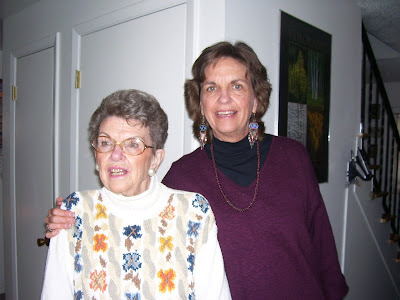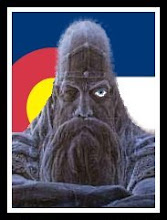CRUSIN' IN CALEB
~THE PRAIRIE GHOST~
On Thursday morning, 20 December, Deborah and I packed up Caleb, our 1996 Dodge Intrepid, with provisions for a Christmas trip to Tucson/Green Valley, Arizona. We pulled onto I-25 heading South about 09:30. Once outside the Front Range megalopolis, Caleb, the name given to the Dodge by my sister Carrie, settled into a comfortable pace, humming along between 75 and 80 mph. We sailed comfortably over the long, rolling waves of the high plains; moving inexorably towards the great break between Colorado and New Mexico, Raton Pass.

Jesus Silva and "Uncle Dick" Wooten
"Raton Pass: Richens Lacy “Uncle Dick” Wooten saw an opportunity to help the travelers on their journey and make a profit as well. He built a passable road, cutting down trees, blasting and clearing rocks, and building bridges. Those who wished to use his road paid $1.50 per wagon and $.05 per head of livestock. Native Americans could use the road for free. Traders continued to use the Santa Fe Trail until 1880 when the railroad extended to Santa Fe. Today, the well-worn trail appears as a ribbon of green grass on the prairie."

The original Native trail over Raton Pass.
Some four hours later we stopped for lunch on the New Mexican high plateau south of Raton. The sky was brilliant, endless blue and the wind cold, dry and clean.

Looking North and West across the high plains.
Next stop, Las Vegas, New Mexico.
I-25 takes a dog leg turn heading west just outside of Santa Fe. We hit early rush hour traffic around 15:30 hours. It took us almost a full two and one half hours to traverse the stretch between Santa Fe and the southern end of Albuquerque. It was a nasty, normal, big city congested traverse, adding a full hour extra to our schedule.
We pulled into Soccorro around 18:00 hours, grabbed a quick meal at the Sonic Drive-in, bought a bottle of Ibuprofen for Deb's throbbing cranial cavity and my burning sciatic nerve and headed south to Truth or Consequenses, our motel room and sleep.
Once there, Caleb had carried us nearly 600 miles.
Inside the motel lobby, behind the check-in counter, amoungst the detrious of Christmas and legal mumbo-jumbo licensure hung a huge stuffed Striper Bass. I had to take a photo for all of the KisPers over at http://www.sondrak.com/, where the saltwater cousin of the striper is an iconic image.

A huge Striper, caught nearby in Elephant Butte Reservoir.

"Elephant Butte Reservoir, created by a dam constructed in 1916 across the Rio Grande, is 40 miles long with more than 200 miles of shoreline. Although constructed to provide for irrigation and flood control, the lake is New Mexico’s premier water recreation facility."
At sunrise the next morning, we rose, brewed some motel coffee, microwaved homemade breakfast burritos and discussed the run to Tucson/ Green Valley. Outside, the behemoth OTR 18 wheel diesels roared to life, ready to carry the lifeblood of commerce down the interstate.

Truth or Consequenses on a winter morning, looking North.
The road south took us along the Rio Grande Valley, following the old Cimmaron/Santa Fe trails. At Hatch, famous for its huge chile pepper crop, we took our leave of I-25, heading South-west on State Highway 26 towards Deming.

The Chile Fanatic: Jesus and Andrea Soto; proprietors
520 W. Hall Street, Hatch, NM 87937
~~~~~~~~~~~~~~~~~~~~~~~~~~~~~~~~~~
Geology Bites:
Down on the valley floor, heading southwest on the two lane, Cookes Peak dominated the horizon. Its 8,300 ft. high, cockscomb crest has been a landmark since time immemorial. The Apache and Mimbres Indian's folklore both mention this unique geological feature. The valley floor's highly saline soil is poor at best, yet dairy and meat ranchers do well in the temperate high desert climate.

Cooke's Peak in the Cooke Range to the north of highway 26.
The whole of this country is uplifted mountain ranges strewn across the remains of old sea beds, seemingly in a helter-skelter fashion. Not all of them are constructed from the same bedrock.

The Florida Range, south of highway 26.

The last of the Burro Range, near Lordsburg, NM.
Most of the uplifts are different ages and types of granite and schist with intrusions of volcanic cuts and quartz. They create a crazy quilt of ranges mostly running north to south, the last of the Southern Rocky Mountain chain in the United States.

Interstate 10 heading west towards Wilcox, the Dragoon
Mountains and Benson.

The unique decomposed granite of Texas Canyon in the
Dragoon Mountains of Arizona.

Looking north towards the Galiuros and Sierra Mountains,
north of Tucson in the soft, Sonoran Desert.
Dropping down from Benson on Interstate 10, we entered the Sonoran desert and headed for Tucson. We had passed through a quick desert rainstorm near Benson and there were storm clouds caught on the peaks north of Tucson.
~~~~~~~~~~~~~~~~~~~~~~~~~~~~~~~~~~
Storms over the Sonoran Desert:
It was blustery and grey when we turned off of I-10 onto I-19 south towards
Green Valley/Tubac/Nogales. The clouds swirled, rain sqawls spit here and there. The weather churned up errant, gusting winds.

Storm clouds gathering to the north of Green Valley.
We pulled into Green Valley about 15:00 hours on Friday, 21 December. Caleb had carried us some 940 miles in two days without so much a hiccup. I figured that we had averaged between 70/75 mph on the interstate, with the exception of the constrictive rush hour between Santa Fe and southern Albuquerque. The milage averaged 27 mpg...not bad for the mountainous climbs, wicked winds and high average speed.

Caleb, the prairie ghost, resting in front of Mom's
townhome in Green Valley.
Deborah and I greeted Mom, her Westphelian terrier, Michalene and shook off the buttsprung road zombies in our bodies. After we unloaded Caleb, the clouds closed in and we had a delightful rain shower.

Mom Anthony, Michalene and her ever-present cigarette.
The Sonoran desert has a unique climate among all the deserts of the Western Hemisphere. It experiences two distinct monsoon seasons, one in early winter and one in mid to late summer. The amount of moisture that actually falls in the form of measurable precipitation is tenuous at best. Total rainfall ranges between 3 inches to 16 inches in a year.
The Northeastern quadrant, best expressed in the environment from Tucson south to Nogales, is respelendent with lowland desert plants, both browse and trees, and montane flora similar to all of the Rocky Mountain chain.

The rich plant life indigenous to the Sonoran Desert.
~THE PRAIRIE GHOST~
On Thursday morning, 20 December, Deborah and I packed up Caleb, our 1996 Dodge Intrepid, with provisions for a Christmas trip to Tucson/Green Valley, Arizona. We pulled onto I-25 heading South about 09:30. Once outside the Front Range megalopolis, Caleb, the name given to the Dodge by my sister Carrie, settled into a comfortable pace, humming along between 75 and 80 mph. We sailed comfortably over the long, rolling waves of the high plains; moving inexorably towards the great break between Colorado and New Mexico, Raton Pass.

Jesus Silva and "Uncle Dick" Wooten
"Raton Pass: Richens Lacy “Uncle Dick” Wooten saw an opportunity to help the travelers on their journey and make a profit as well. He built a passable road, cutting down trees, blasting and clearing rocks, and building bridges. Those who wished to use his road paid $1.50 per wagon and $.05 per head of livestock. Native Americans could use the road for free. Traders continued to use the Santa Fe Trail until 1880 when the railroad extended to Santa Fe. Today, the well-worn trail appears as a ribbon of green grass on the prairie."

The original Native trail over Raton Pass.
Some four hours later we stopped for lunch on the New Mexican high plateau south of Raton. The sky was brilliant, endless blue and the wind cold, dry and clean.

Looking North and West across the high plains.
Next stop, Las Vegas, New Mexico.
I-25 takes a dog leg turn heading west just outside of Santa Fe. We hit early rush hour traffic around 15:30 hours. It took us almost a full two and one half hours to traverse the stretch between Santa Fe and the southern end of Albuquerque. It was a nasty, normal, big city congested traverse, adding a full hour extra to our schedule.
We pulled into Soccorro around 18:00 hours, grabbed a quick meal at the Sonic Drive-in, bought a bottle of Ibuprofen for Deb's throbbing cranial cavity and my burning sciatic nerve and headed south to Truth or Consequenses, our motel room and sleep.
Once there, Caleb had carried us nearly 600 miles.
Inside the motel lobby, behind the check-in counter, amoungst the detrious of Christmas and legal mumbo-jumbo licensure hung a huge stuffed Striper Bass. I had to take a photo for all of the KisPers over at http://www.sondrak.com/, where the saltwater cousin of the striper is an iconic image.

A huge Striper, caught nearby in Elephant Butte Reservoir.

"Elephant Butte Reservoir, created by a dam constructed in 1916 across the Rio Grande, is 40 miles long with more than 200 miles of shoreline. Although constructed to provide for irrigation and flood control, the lake is New Mexico’s premier water recreation facility."
At sunrise the next morning, we rose, brewed some motel coffee, microwaved homemade breakfast burritos and discussed the run to Tucson/ Green Valley. Outside, the behemoth OTR 18 wheel diesels roared to life, ready to carry the lifeblood of commerce down the interstate.

Truth or Consequenses on a winter morning, looking North.
The road south took us along the Rio Grande Valley, following the old Cimmaron/Santa Fe trails. At Hatch, famous for its huge chile pepper crop, we took our leave of I-25, heading South-west on State Highway 26 towards Deming.

The Chile Fanatic: Jesus and Andrea Soto; proprietors
520 W. Hall Street, Hatch, NM 87937
~~~~~~~~~~~~~~~~~~~~~~~~~~~~~~~~~~
Geology Bites:
Down on the valley floor, heading southwest on the two lane, Cookes Peak dominated the horizon. Its 8,300 ft. high, cockscomb crest has been a landmark since time immemorial. The Apache and Mimbres Indian's folklore both mention this unique geological feature. The valley floor's highly saline soil is poor at best, yet dairy and meat ranchers do well in the temperate high desert climate.

Cooke's Peak in the Cooke Range to the north of highway 26.
The whole of this country is uplifted mountain ranges strewn across the remains of old sea beds, seemingly in a helter-skelter fashion. Not all of them are constructed from the same bedrock.

The Florida Range, south of highway 26.

The last of the Burro Range, near Lordsburg, NM.
Most of the uplifts are different ages and types of granite and schist with intrusions of volcanic cuts and quartz. They create a crazy quilt of ranges mostly running north to south, the last of the Southern Rocky Mountain chain in the United States.

Interstate 10 heading west towards Wilcox, the Dragoon
Mountains and Benson.

The unique decomposed granite of Texas Canyon in the
Dragoon Mountains of Arizona.

Looking north towards the Galiuros and Sierra Mountains,
north of Tucson in the soft, Sonoran Desert.
Dropping down from Benson on Interstate 10, we entered the Sonoran desert and headed for Tucson. We had passed through a quick desert rainstorm near Benson and there were storm clouds caught on the peaks north of Tucson.
~~~~~~~~~~~~~~~~~~~~~~~~~~~~~~~~~~
Storms over the Sonoran Desert:
It was blustery and grey when we turned off of I-10 onto I-19 south towards
Green Valley/Tubac/Nogales. The clouds swirled, rain sqawls spit here and there. The weather churned up errant, gusting winds.

Storm clouds gathering to the north of Green Valley.
We pulled into Green Valley about 15:00 hours on Friday, 21 December. Caleb had carried us some 940 miles in two days without so much a hiccup. I figured that we had averaged between 70/75 mph on the interstate, with the exception of the constrictive rush hour between Santa Fe and southern Albuquerque. The milage averaged 27 mpg...not bad for the mountainous climbs, wicked winds and high average speed.

Caleb, the prairie ghost, resting in front of Mom's
townhome in Green Valley.
Deborah and I greeted Mom, her Westphelian terrier, Michalene and shook off the buttsprung road zombies in our bodies. After we unloaded Caleb, the clouds closed in and we had a delightful rain shower.

Mom Anthony, Michalene and her ever-present cigarette.
The Sonoran desert has a unique climate among all the deserts of the Western Hemisphere. It experiences two distinct monsoon seasons, one in early winter and one in mid to late summer. The amount of moisture that actually falls in the form of measurable precipitation is tenuous at best. Total rainfall ranges between 3 inches to 16 inches in a year.
The Northeastern quadrant, best expressed in the environment from Tucson south to Nogales, is respelendent with lowland desert plants, both browse and trees, and montane flora similar to all of the Rocky Mountain chain.

The rich plant life indigenous to the Sonoran Desert.
~~~~~~~~~~~~~~~~~~~~~~~~~~~~~~~~~~
Last Days in Advent:
My brother John arrived and we all began holiday preparations, decorating the house, recalling past Christmases and enjoying one another's company and great food, which required long walks to burn some of the extra calories.
The following are photos taken around Mom's townhouse during the two days prededing Christmas:
Dry wash (Arroyo seco) scoured by flash floods during the
Summer Monsoons.
Palo Verde tree (upper left), Cholla (upper right) and
various sub-species of prickly-pear.
More indigenous plants in the park just west of Mom's
house. Palo Verde, Palo Duro, Desert Ponderosa and
Mesquite trees; Saguaro, Cholla, Barrel and the ubiquitous,
omnipresent Prickly pear cacti.
The lightly lavendar colored varient of Prickly Pear.
Introduced flora in the well groomed and
maintained landscape of Green Valley.
In the backround,Mt. Lemmon rises
to 9,000+ feet in altitude.
Sunset, Christmas Eve, 2007. The photo barely captures
the intense colors.
~~~~~~~~~~~~~~~~~~~~~~~~~~~~~~~~~~
Christmas Celebrations:
We awoke to a chilly Christmas morning, barely above the magic 32 degrees Farenheit.
Christmas morn, before the day began.
Deb and John teasing Mom...who is complaining about
the cold and remains chilled all winter.
She despises the cold, a true desert rat.
The requisite family portrait at Christmas.
Early Christmas evening, our long time friends the Kelly/Madrazo family joined us in a wonderful buffet of smoked meats, scalloped potatoes and fresh fruit and veges salads.
The Kelly/Madrazo family has an interesting history. Carmen Madrazo is a native of Guatemala. Her family owns multiple farms, raising coffee and vegetables. She married early, had four children by her first husband, then divorced him for reasons which are not mine to share.
Joseph Kelly was a Catholic priest of the Maryknoll order. While serving in Mission work in Guatemala, he met Carmen (Chiqui). They fell in love, Joe retired from the priesthood and married Chiqui, adopting her four children. He and Chiqui have one daughter from their marriage.
(left to right) John Anthony, Lorena (Lori) Madrazo, Carmen
(Chiqui) Kelly, Joseph Kelly, Jorge (George) Madrazo and
Mom Anthony.
Another shot of the festivities.
One more shot of the feast.








































